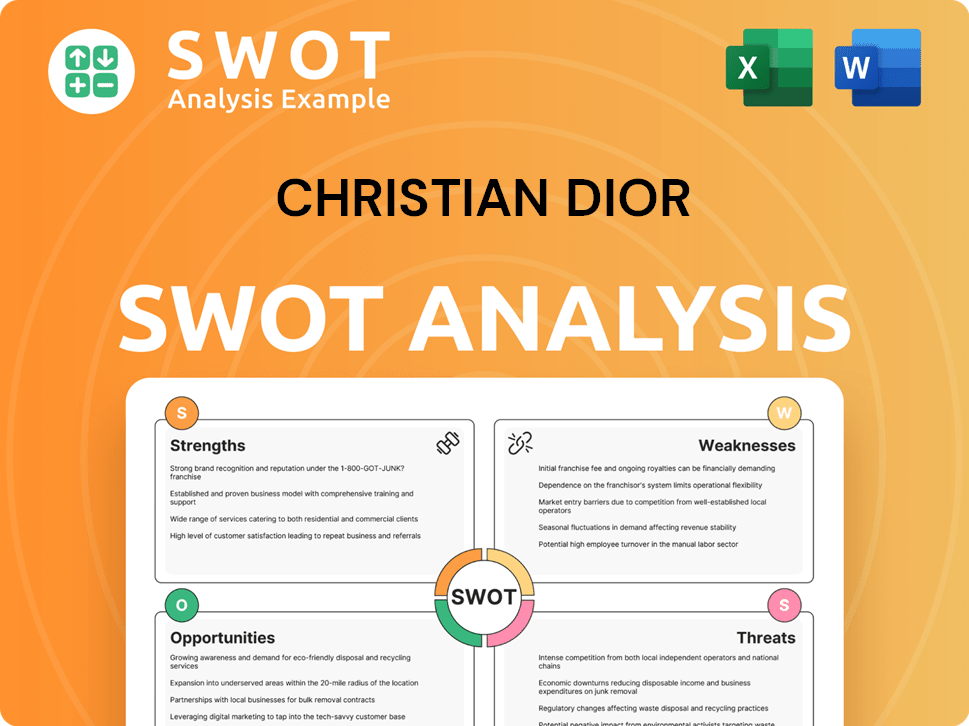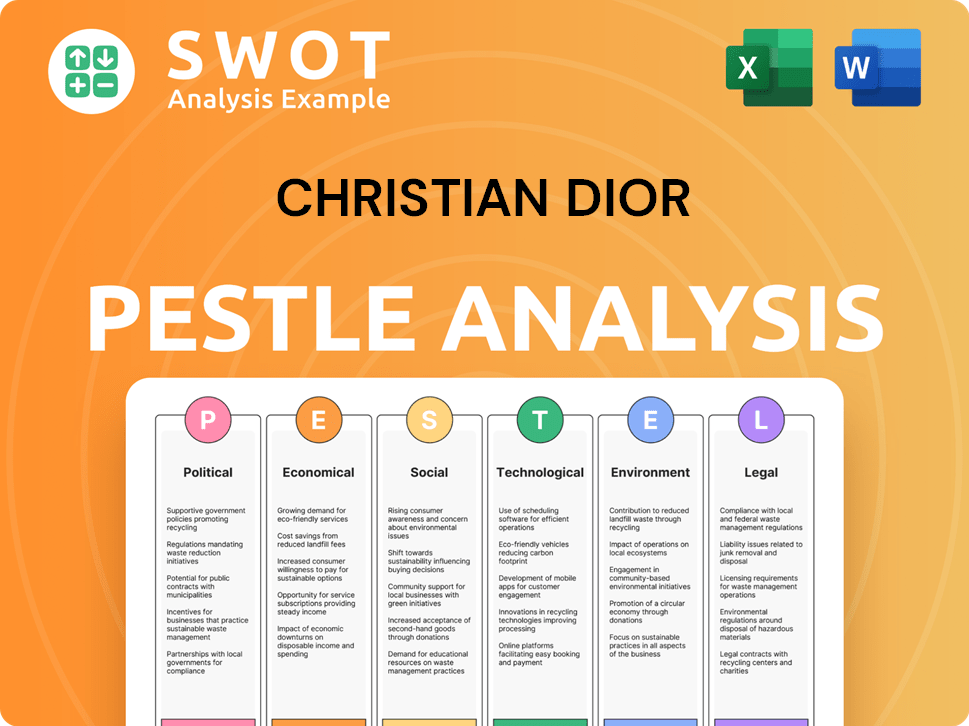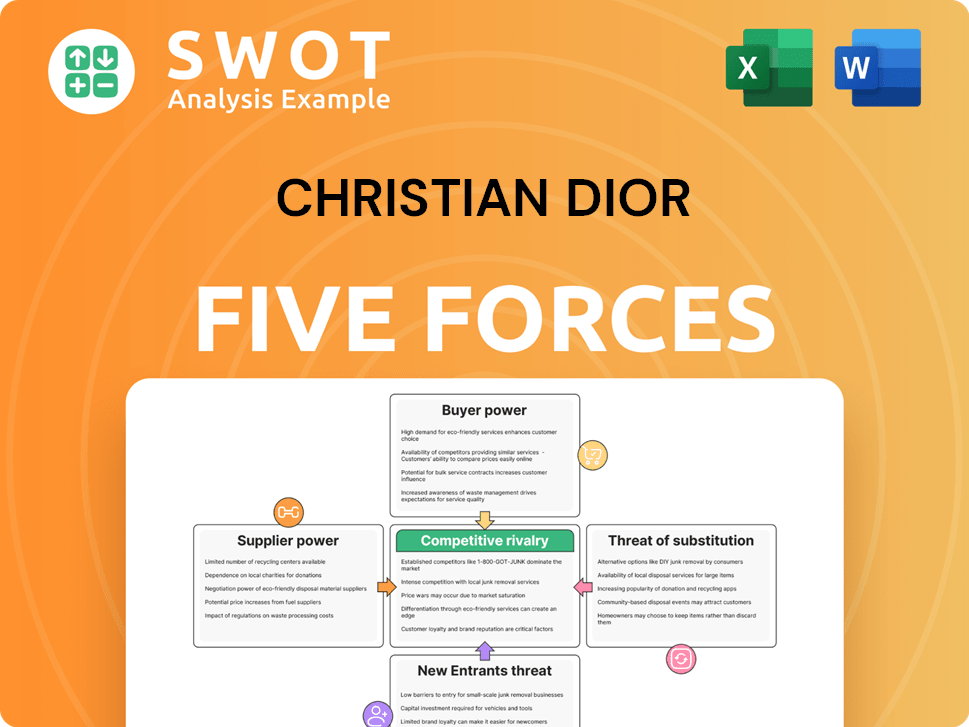Christian Dior Bundle
How Did Christian Dior Revolutionize Fashion?
Step into the glamorous world of Christian Dior SWOT Analysis, a luxury brand that redefined elegance. From its inception in post-war Paris, this French designer transformed the fashion landscape. Discover the Dior history and how a single collection sparked a fashion revolution, shaping the future of haute couture.

The Dior company's story began in 1946, with the vision of restoring Paris to its fashion dominance. Christian Dior's 'New Look' collection, unveiled in 1947, was a pivotal moment, symbolizing a return to femininity and opulence. This luxury brand quickly evolved from a Parisian atelier to a global powerhouse, leaving an indelible mark on the fashion house landscape.
What is the Christian Dior Founding Story?
The Christian Dior company, a name synonymous with luxury and elegance, was founded on December 16, 1946. The visionary behind the brand was Christian Dior, a French designer who saw an opportunity to reshape the fashion landscape after World War II. His goal was to bring a sense of joy and beauty back into women's lives through innovative designs.
The early days of the Dior fashion house were marked by a bold vision. Dior aimed to revive French fashion, which had suffered during the war. This ambition led to the creation of a brand that would become a global icon. The initial business model centered around haute couture, catering to an elite clientele with bespoke, high-fashion garments.
The launch of the first collection in February 1947 was a pivotal moment. It introduced the 'New Look,' a silhouette that revolutionized fashion. This collection, which was a stark contrast to the utilitarian styles of the time, quickly gained recognition. The company's success was fueled by a desire for glamour and optimism in the post-war era.
Christian Dior's company was established in 1946 with the aim of revitalizing French fashion after World War II.
- Christian Dior secured initial funding of 60 million French francs from Marcel Boussac.
- The first collection, introduced in February 1947, featured the 'New Look' silhouette.
- The company's initial focus was on haute couture, catering to an elite clientele.
- The brand's success reflected a post-war desire for glamour and optimism.
The financial backing for Christian Dior came from Marcel Boussac, a textile magnate. Boussac invested 60 million French francs and provided the building at 30 Avenue Montaigne. This support allowed Dior to establish a grand fashion house from the outset. The company's name, simply Christian Dior, reflected the founder's personal brand and artistic vision.
The early success of the Dior company demonstrated a significant demand for glamour and beauty. The luxurious designs were a bold counterpoint to the austerity of the post-war period. This demand helped establish Dior's place in the fashion world. The cultural context of post-war recovery influenced the company's creation, with Dior aiming to bring joy through his designs. To learn more about the brand's approach, consider reading about the Marketing Strategy of Christian Dior.
Christian Dior SWOT Analysis
- Complete SWOT Breakdown
- Fully Customizable
- Editable in Excel & Word
- Professional Formatting
- Investor-Ready Format

What Drove the Early Growth of Christian Dior?
The early growth of the Dior company was exceptionally rapid, significantly influenced by the success of the 'New Look'. Following its debut in 1947, the French designer rapidly expanded its haute couture offerings. This expansion solidified Paris as the undisputed center of global fashion. Early product launches included haute couture collections and the introduction of fragrances, diversifying revenue streams beyond bespoke clothing.
The initial product launches included subsequent haute couture collections and the introduction of fragrances. The iconic Miss Dior perfume, launched in 1947, played a crucial role. This strategic move into perfumes allowed for wider accessibility and brand recognition for the luxury brand.
Christian Dior quickly attracted a prestigious international clientele. This included Hollywood stars and European royalty, solidifying its reputation. The atelier at 30 Avenue Montaigne became the primary operational hub. The team expanded significantly with skilled seamstresses, pattern makers, and sales staff.
International expansion began almost immediately, with licensing agreements for ready-to-wear and accessories in the United States by the early 1950s. This allowed Dior to tap into the lucrative American market. This strategic shift moved beyond the exclusive haute couture model to a broader, albeit still luxury, market.
Leadership transitioned after Christian Dior's death in 1957. Yves Saint Laurent, his young protégé, became artistic director. He maintained the house's creative momentum, introducing new silhouettes. This period saw continued growth, despite competitive pressures from other emerging designers.
Christian Dior PESTLE Analysis
- Covers All 6 PESTLE Categories
- No Research Needed – Save Hours of Work
- Built by Experts, Trusted by Consultants
- Instant Download, Ready to Use
- 100% Editable, Fully Customizable

What are the key Milestones in Christian Dior history?
The history of Christian Dior, a renowned French designer and luxury brand, is marked by significant milestones that have shaped its legacy in the fashion world. From its inception to its current status, the Dior company has consistently evolved, setting trends and overcoming challenges to maintain its position as a leading fashion house.
| Year | Milestone |
|---|---|
| 1946 | Christian Dior founded his fashion house, marking the beginning of a new era in haute couture. |
| 1947 | The 'New Look' collection was introduced, revolutionizing post-war fashion with its innovative silhouette. |
| 1957 | Christian Dior's sudden death led to a period of transition, with Yves Saint Laurent taking over as head designer. |
| 1985 | The company was acquired by Bernard Arnault, who later became the chairman of LVMH, expanding Dior's global reach. |
| 1990s-2000s | John Galliano's appointment as creative director brought avant-garde designs and revitalized the brand. |
| 2016 | Maria Grazia Chiuri became the first female artistic director, bringing a new perspective to the brand. |
Innovations have been central to the Dior company's success. The brand expanded into fragrances and cosmetics, broadening its appeal and establishing a diversified luxury empire. Licensing agreements were also pioneered, enabling wider distribution and enhancing brand recognition.
Christian Dior's 'New Look' in 1947 revolutionized fashion with its cinched waist and full skirt, setting a new standard for post-war glamour. This collection marked a significant shift from the utilitarian styles of the war years, showcasing Dior's innovative vision.
Dior's strategic move into fragrances and cosmetics expanded its market reach. This diversification allowed the brand to connect with a broader audience, making luxury more accessible while maintaining its high-end image.
Dior was an early adopter of licensing agreements, a strategy that facilitated wider distribution and brand recognition. This approach allowed Dior to expand its presence globally, reaching new markets and increasing its visibility.
In recent years, Dior has increased its focus on digital engagement and sustainability initiatives. These efforts reflect the brand's adaptation to contemporary trends, appealing to a younger, more environmentally conscious consumer base. The brand has also been investing in sustainable materials and practices.
The brand has consistently adapted to changing trends through strategic leadership changes. These shifts have brought in new creative visions, ensuring the brand's continued relevance and ability to innovate within the luxury market.
Dior has consistently reinvented itself through creative reinvention, with each artistic director bringing a unique perspective. From the avant-garde designs of John Galliano to the modern vision of Maria Grazia Chiuri, Dior has maintained its position as a trendsetter.
The Dior company has faced several challenges throughout its history. The death of Christian Dior in 1957 created internal uncertainty, requiring the brand to adapt quickly. Market downturns and evolving consumer preferences have also necessitated strategic shifts in design and marketing.
The sudden death of Christian Dior in 1957 was a major crisis, requiring the brand to quickly adapt and find new creative leadership. Subsequent transitions have also presented challenges, demanding that the company maintain its core values while embracing new visions.
Dior has had to navigate changing fashion trends, requiring constant adaptation in design and marketing. The brand has consistently evolved its collections to stay relevant, appealing to contemporary tastes while maintaining its luxury status.
Economic downturns and market pressures have presented ongoing challenges, requiring Dior to adjust its strategies. The brand has demonstrated resilience, adapting its business model to maintain profitability and brand value during uncertain times.
The luxury market is highly competitive, with new brands and changing consumer preferences. Dior has faced the challenge of maintaining its market share and brand prestige, requiring continuous innovation and strategic marketing efforts.
The company has faced the challenge of maintaining its brand identity while adapting to new trends and leadership changes. Dior has successfully balanced its heritage of elegance and craftsmanship with contemporary design elements.
The brand has had to manage controversies and public perception, particularly during periods of significant creative shifts. Dior has addressed these challenges through strategic communication and by reaffirming its commitment to its core values.
Christian Dior Business Model Canvas
- Complete 9-Block Business Model Canvas
- Effortlessly Communicate Your Business Strategy
- Investor-Ready BMC Format
- 100% Editable and Customizable
- Clear and Structured Layout

What is the Timeline of Key Events for Christian Dior?
The Dior history is marked by pivotal moments that have shaped the luxury brand's legacy. From its inception in post-war Paris to its current status as a global fashion house, Christian Dior has consistently evolved while maintaining its commitment to elegance. The brand's journey includes iconic collections, influential designers, and strategic expansions, all contributing to its enduring appeal in the luxury market.
| Year | Key Event |
|---|---|
| 1946 | Christian Dior SE founded in Paris, France, establishing the foundation for the future luxury brand. |
| 1947 | Launch of the 'New Look' collection revolutionized post-war fashion with its innovative silhouette. |
| 1947 | Introduction of the iconic Miss Dior fragrance marked the brand's entry into perfumes, expanding its product range. |
| 1949 | First licensing agreements signed in the United States expanded the brand's global reach, initiating international growth. |
| 1957 | Christian Dior's untimely death led to Yves Saint Laurent's appointment as artistic director, signaling a transition. |
| 1960 | Marc Bohan took over as artistic director after Saint Laurent's departure, continuing the brand's evolution. |
| 1980s | Acquisition by Bernard Arnault and integration into LVMH Moët Hennessy Louis Vuitton, integrating the brand into a luxury conglomerate. |
| 1990s | John Galliano appointed artistic director, ushering in dramatic, theatrical designs that redefined the brand's aesthetic. |
| 2012 | Raf Simons appointed artistic director, bringing a more minimalist aesthetic, offering a fresh perspective. |
| 2016 | Maria Grazia Chiuri appointed the first female artistic director for women's haute couture and ready-to-wear, representing a historic milestone. |
| 2023-2024 | Continued strong performance within the LVMH group, with significant contributions to LVMH's fashion and leather goods division, which reported revenue of €42.17 billion in 2023, representing a 14% organic growth. |
| 2024 | Dior continues to invest in global retail expansion, particularly in key luxury markets like China and the Middle East, to increase its presence. |
| 2025 | Focus on integrating advanced sustainable practices across its supply chain and product lifecycle, aligning with broader industry shifts towards environmental responsibility. |
Dior is expected to increase its presence in emerging markets, capitalizing on the growing demand for luxury goods. This includes strategic investments in retail locations and targeted marketing campaigns. The brand's expansion strategy is focused on regions with high growth potential, such as Asia and the Middle East.
Enhancing customer engagement through digital platforms and e-commerce is a key focus. Dior will likely invest in improving its online shopping experience and expanding its digital marketing efforts. This includes personalized content and interactive features to connect with consumers.
Dior is committed to integrating sustainable practices throughout its operations. This includes sourcing materials responsibly and reducing its environmental impact. The company will likely focus on transparency and ethical sourcing to meet consumer expectations.
The brand is set to strengthen its position in high-end jewelry and watches, building on its existing success in these segments. This involves introducing new collections and expanding its retail presence in these categories. Dior is expected to continue innovating in these luxury areas.
Christian Dior Porter's Five Forces Analysis
- Covers All 5 Competitive Forces in Detail
- Structured for Consultants, Students, and Founders
- 100% Editable in Microsoft Word & Excel
- Instant Digital Download – Use Immediately
- Compatible with Mac & PC – Fully Unlocked

Related Blogs
- What is Competitive Landscape of Christian Dior Company?
- What is Growth Strategy and Future Prospects of Christian Dior Company?
- How Does Christian Dior Company Work?
- What is Sales and Marketing Strategy of Christian Dior Company?
- What is Brief History of Christian Dior Company?
- Who Owns Christian Dior Company?
- What is Customer Demographics and Target Market of Christian Dior Company?
Disclaimer
All information, articles, and product details provided on this website are for general informational and educational purposes only. We do not claim any ownership over, nor do we intend to infringe upon, any trademarks, copyrights, logos, brand names, or other intellectual property mentioned or depicted on this site. Such intellectual property remains the property of its respective owners, and any references here are made solely for identification or informational purposes, without implying any affiliation, endorsement, or partnership.
We make no representations or warranties, express or implied, regarding the accuracy, completeness, or suitability of any content or products presented. Nothing on this website should be construed as legal, tax, investment, financial, medical, or other professional advice. In addition, no part of this site—including articles or product references—constitutes a solicitation, recommendation, endorsement, advertisement, or offer to buy or sell any securities, franchises, or other financial instruments, particularly in jurisdictions where such activity would be unlawful.
All content is of a general nature and may not address the specific circumstances of any individual or entity. It is not a substitute for professional advice or services. Any actions you take based on the information provided here are strictly at your own risk. You accept full responsibility for any decisions or outcomes arising from your use of this website and agree to release us from any liability in connection with your use of, or reliance upon, the content or products found herein.